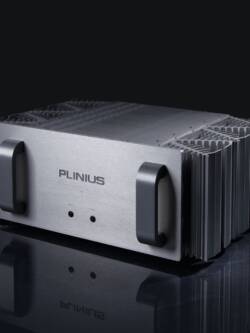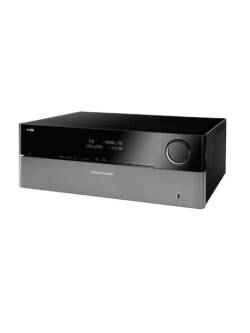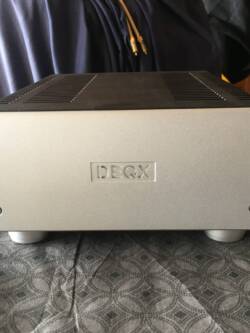Electrocompaniet ECI6 DX MK2 Integrated Amplifier/DAC/Phono (NEW)
Original price was: R182,000.00.R98,000.00Current price is: R98,000.00.
This a 3 month old set, NEW condition and under WARRANTY. MINT
Electrocompaniet ECI 6 DX MKII Int. Streaming Amp Review
A Norwegian thoroughbred with power and lossless hi-res streaming music finesse.
Review By Phil Gold
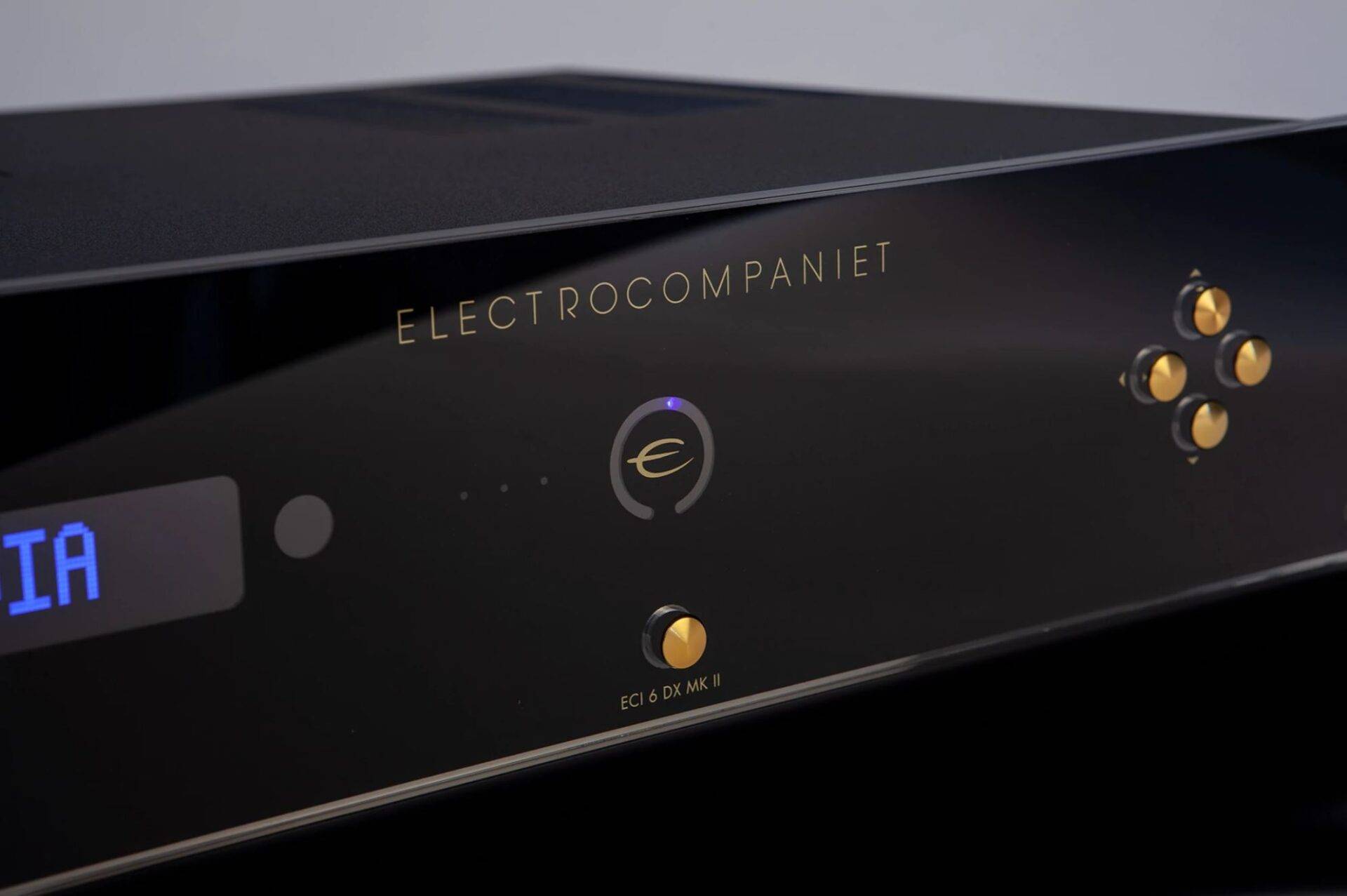
You may have heard of Dr. Matti Otala of the Tampere University in Finland. Even if you haven’t, the fine sound that the best transistor amplifiers are capable of today is a direct result of his pioneering work in the seventies on Transient Intermodulation (TIM). This is a type of distortion, previously unidentified, produced by early transistor amplifiers which made them so tiresome to listen to. Per Abrahamsen and Svein Erik Børja read Dr. Otala’s paper and set out to design a transistor amplifier that would minimize TIM. Their 25 Watt amplifier, introduced in 1976 really did change the world and won their new Norwegian company, Electrocompaniet, many fans and customers including Bruce Swedian (Michael Jackson’s producer). He used Electrocompaniet amps to master Michael Jackson’s albums HIStory and Invincible. Electrocompaniet amplifiers found their way into many recording studios around the world including Abbey Road.
But things eventually went wrong for Electrocompaniet and in 2004 they went bankrupt. Three years later, the company was bought by the Norwegian company Westcontrol with their offices and production then moved to Tau, which is outside Stavenger in Norway.
To compete with Chinese sourced products, Westcontrol built a large and highly automated production line for Electrocompaniet components, which greatly reduced labor costs and improved construction quality and reliability. Their Classic Line has a restrained appearance and covers separates and integrated amps, CD Players, streamers, all the way up to the 600 Watt Nemo monoblock amplifier which weighs over 90 lbs. They also produce a wireless lifestyle range called EC Living.
The Details
Today’s review of Electrocompaniet’s ECI 6 DX MKII integrated streaming amplifier component is one of two versions of the ECI 6 MKII Line. ECI 6 MKII is a conventional integrated amplifier, while the ECI 6 DX MKII adds a DAC and streaming circuitry. The ECI 6 MKII range is based on the earlier ECI 5 MKII but comes with an improved power supply and a more sophisticated preamp section. The unit is black with five gold buttons, a small status panel, and an LED volume indicator which describes an arc around the centrally located power indicator. Minimalist to a fault.
The rear is much busier with mains input, loudspeaker binding posts, and five digital inputs (TosLink 1, USB, Coax 1, Coax 2, TosLink 2). For analog inputs, there are three unbalanced RCA input pairs plus one XLR balanced pair. For music streamers, two streaming inputs are USB and wired LAN. Other jacks on the back include unbalanced RCA and balanced XLR preamp outputs, RS-232, and in/out 12 Volt triggers. You can’t see it, but the unit also links to your network wirelessly via Wi-Fi and through Bluetooth. That’s an ocean of connectivity.

I had one stroke of luck when using this amp in my system. The remote control for the Electrocompaniet just happens to control my EMM Labs XDS CD/SACD Player. With one exception – when you press “Stop” the transport does stop, but the input on the Electrocompaniet automatically switches to MEDIA because it thinks you’ve finished with that source, and now you want to stream. Not a bug – a feature.
I ran into one problem with Electrocompaniet’s ECI 6 DX MKII that you certainly won’t experience. If you use spade connectors with an inflexible stretch of cable close to the spade, such as on my Nordost Valhalla 2 speaker cables, the left speaker negative cable may obstruct the mains input, and the right speaker negative cable may obstruct the left balanced preamp out connector. This is because my unit came fitted with European safety compliant WBT binding posts, which only accept spades at one particular angle. I raised this issue with the company. They contacted the Norwegian distributor of Nordost to discuss and they said they mostly sold bananas rather than spades in Europe because of this issue.

Electrocompaniet said they would immediately change the production for North American units to use standard binding posts without the plastic protective collar which dictates the angle of the spades. Apparently this is an issue that many European companies face because of EU safety regulations. I looked inside to see if I could remove the collar myself, or rotate it to a better angle, but because of the way the binding posts are connected internally, this turned out to be a dead end. I switched to banana cables and avoided the problem altogether. I am very happy with how responsive the company was to this issue, which they had never come across before. I took this picture to illustrate.

You all know what an integrated amplifier can do. This one offers 125 Wpc into 8 Ohms, 200 Wpc into 4 Ohms, and 370 Wpc into 2 Ohms. That means it must have a substantial power supply, and you can feel that when you lift it up. Despite its relatively compact dimensions of 19.3″ wide by 16.9″ deep and 5″ high, it weighs a good 45 lbs. Much of that weight must have gone into the power supply and rigid chassis.
True Lossless 24-bit/192kHz Streaming Music Delights
This box does not have cooling fins like some powerful amps. Instead, there are slots in the chassis on both sides to allow hot air to escape. You can see much of the innards through these slots, which are too narrow for prying fingers. You won’t find any tone or balance controls, tape loop, or a headphone amp, but this unit has a great deal of flexibility to offer. Not just three different types of digital input, as it also includes streaming through wired Ethernet, Bluetooth, Wi-Fi, USB, plus a direct connection to internet radio. Streaming music services supported include Qobuz, Tidal, and Spotify.
Electrocompaniet’s ECI 6 DX MKII integrated streaming amplifier can even act as a Roon endpoint. You can control the amp from the front panel, its dedicated 51 button plastic remote or the EC Play app on your phone, my preference. With this, I can access the library of files I have stored on the exaSound Delta Server, Radio, Qobuz, Spotify, and Tidal through the Media input (USB). All things are well laid out and easy to learn.
I will divide my listening tests into two sections. First is a review of the ECI 6 MK II integrated amplifier – the ECI 6 DX MK II without the digital module. The second half will audition the DAC and streaming module – the DX in the amp’s name.
Since the amplifier does not have line-level inputs, I treated it as an integrated amp rather than testing the preamp and power amp sections separately. And I’m delighted to say that the performance was impressive across all frequencies and decibels. It isn’t the most dynamic amplifier out there, but it does a fine job of controlling the ultra-revealing and current-loving YG Acoustics Hailey 2.2 speakers. The bass is strong and deep, the treble extended and non-fatiguing, the midrange revealing, while the spatial characteristics were strong for this price point, if somewhat flattened compared to an ultimate reference.
To test out this performance I used the EMM Labs XDS1 both directly as a CD/SACD player, and again as the transport to an EMM Labs DV2 DAC. I also used a Meridian G08 CD player, but I will talk about this later within the digital section of this review.

Amplification Powerhouse
The amp is equally comfortable in all types of music, which is good because I play all types of music, except maybe country. And my standards for amp quality are pretty demanding. When an amp has control over the speakers, the instruments and voices show realistic timbre and color. The music simply flows, so we are onto a good thing and your mind and your body tells you. You can’t sit still when exciting music plays, and you don’t find yourself pining for the megabuck Swiss amp you’re using for reference.
So it is with Electrocompaniet ECI 6 DX MKII integrated streaming amp both through its balanced XLR and unbalanced RCA inputs. Certainly when the EMM Labs DV2 is converting the bits to analog. Yes, there is a drop in realism and dynamism when you allow the EMM Labs XDS1 to perform D to A conversion, and a markedly bigger drop when the lower performance Meridian G08 is handling that task. But the fact that these source changes are so noticeable is testament to the superior abilities of this Electrocompaniet unit.
Now it’s not perfect. Nothing is. Its’ biggest shortcoming is the subtle flattening of both dynamic range and attack, and the smaller and less coherent imaging compared to the reference Soulution 511 power amp fed by the variable output of the EMM Labs DV2 DAC. But this is a different price point altogether. Having had multiple integrated amps pass through my system, I would place this a little ahead of the excellent tube-based Copland CTA408, and well ahead of the $20,000 Yamaha C5000 Pre and M5000 Power separates in terms of musicality.
But as you would expect from the size of the box, it is not designed for high volume output on low-efficiency speakers. There are bigger amps in their line-up designed for that task. Specified distortion levels (THD < 0.004% from 20Hz to 20kHz) and bandwidth (1Hz to 150kHz) are excellent. I heard nothing that would make me think otherwise. Maximum peak current exceeds 100 Amperes, which attests to its ability to cope with the massive transient demands of a Mahler symphony without breaking a sweat.
The second part of the auditioning is a different story. Now we are talking about the DAC and Streamer section, which is in my view not quite in the same class as the analog sections. Using CDs, I compared the same music decoded by the XDS1, The DV2, and the Meridian G08 to the TosLink digital input from the Meridian G08 and to USB replay of stored files on my server.

Time Marches Onward
I reviewed Meridian’s G08 upsampling CD player within these cyberpages back in 2004 and I still hold it in high esteem. It was outstanding at the time, and can hold its own today against many current products, but it is no longer state of the art. It does not achieve the resolution of today’s best, nor their superb signal-to-noise ratio that allows low-level details to emerge against a black background. If the DV2 rates a 10, then the XDS1 rates an 8 and the Meridian G08 a 5 or a 6. I found the DAC section of the Electrocompaniet amp matches and slightly improves on the G08 on Redbook material. So, it’s good, very good in fact, but not excellent.
Compared to the $30,000 reference DAC, an obviously unfair comparison if I am not taking price into consideration, I found the imaging shrinking in towards the speakers, with less texture on the instruments. Overall, it offers a less relaxing and involving experience. Foot tapping dropped proportionately. The extent of this step down in realism varied from disk to disk. Artur Rubinstein playing Chopin Sonatas on JVC [JM XR24008] is a wonderful performance but a recording that is very difficult to bring to life. On many systems it can sound heavy and rolled off.
Using the DV2 DAC, the piano sings with a firm bass and an extended upper range above a luminous midrange. The Meridian G08 DAC maintains a good deal but far from all this realism, and the Toslink input on the Electrocompaniet a little more, but in neither case can you really appreciate the superb tone that Rubinstein could coax from his instrument. Heard this way, the recording sounds its age (1961), and you wouldn’t go out of your way to buy this much sought after XRCD24 release.
Leonard Cohen’s final disk You Want It Darker [Columbia 88985365072] is another disk that can sound bass heavy unless you have an excellent replay chain. On the G08 and through the Toslink input, the sound never really opened up. It sounded somewhat tired and morose, but through the XDS1’s DAC section and especially through the DV2 DAC, the music came to life. Cohen is opening his soul to you – it’s a privilege to be experiencing his final testament, just as it was a privilege and the thrill of a lifetime to hear him at close range during his final tour with his handpicked musicians and backing singers.
It’s the clarity of the high frequencies, the solidity of the bass and the exceptional dynamic range that distinguish the good DAC from the great DAC. But on Astor Piazzolla’s great recording Tango:Zero Hour [JAM 9110-2] the difference between the various DACs narrowed significantly and I was very happy with the DX section’s execution. The same can be said of Haydn’s Quartets Opus 20 [Astree E8786] which kept me fully involved. Buena Vista Social Club [Nonesuch 79478-2] fell somewhere between these two extremes. Yes, the DV2 was better, but the Electrocompaniet’s TosLink input was pretty damn good too. Love that disk!
Now a switch to higher resolution music, some wirelessly through Qobuz accessed directly through the EC Play app and others from high res files stored on my exaSound Delta Server and accessed through the USB input. I also compared the same tracks (some DSD and some 24-bit at 192kHz or 96kHz) to the DV2 DAC using SACD disks played on the transport in the XDS1. Note that the two EMM components are connected using EMM Link, a version of ATT glass, which transmits the DSD signal from transport to DAC without conversion.
Compared to its performance on Redbook, I could certainly hear a significantly sweeter and more musical sound playing hi res tracks of all types through the Electrocompaniet’s DAC, with no difference noted between Qobuz and my server’s version of the same tracks. The imaging improved quite a bit, filling in the hole between the speakers. Sound quality exceeded that of Redbook from the Meridian G08 – maybe a 7.5 on that 10 point scale. But that high res sound was still not as refined as a Redbook track converted to analog on the XDS1 or on the XDS1/DV2 combination. It could not match the spaciousness or the blackness between the notes, although the imaging now matches Redbook through the XDS1. But the sound of SACD through the DV2 and into the balanced inputs of the Electrocompaniet showed an even bigger improvement. And you would expect nothing less.

Electrocompaniet’s ECI 6 DX MKII Overachiever Impresses
There was also much more consistency in the relationship between the three DAC’s (XDS1, DV2 and Electrocompaniet. I think this makes sense. It is an easier task for a DAC to sound really good on hi-res material of all kinds, while Redbook presents many challenges in the filtering area as well as upscaling which can lead to a notable loss of realism. To make Redbook sound good is quite the challenge. Somehow EMM Labs, Chord, dCS, and some others manage this, but rarely at a reasonable price.
I haven’t mentioned price until this point because I want you to understand what you are getting before you judge what kind of value is on offer. In fact, until this exact moment, I have not checked the prices myself. My guess is around $6500 for the base ECI 6 Mk II and $8500 for the ECI 6 DX Mk II.
And the actual prices: $6000 and $7500 respectively. I think the analog-only ECI 6 Mk II is fully competitive on features and specification and offers unusually good sound for the price, while the DX version, at just $1500 more, is an overachiever. It has all the great sound of the base model with all the convenience of a good flexible streaming DAC. It’s $7500 well spent.
As to your friends, if they are Hi-Fi Mavins, they will be impressed that you own an Electrocompaniet. If they are not, they will be equally impressed once you start playing them some music. Not flashy here but thoroughly musical.
Running in Class A the input stage has zero feedback while the output stage runs with moderate feedback, that Electrocompaniet advises, is there to deliver a good balance of sound from bass to top The 6DX and its Amplifier sibling delivers a respectable if not earth-shattering 125W into 8ohms, 200W into 4 and a listed 370W into 2ohms with a very good -135db noise floor preamp wise. As with all Class A it gets warm so you need to give it air to breathe so don’t be cramming it into a tight unit, there are adequate vents and heat sinks but give it room.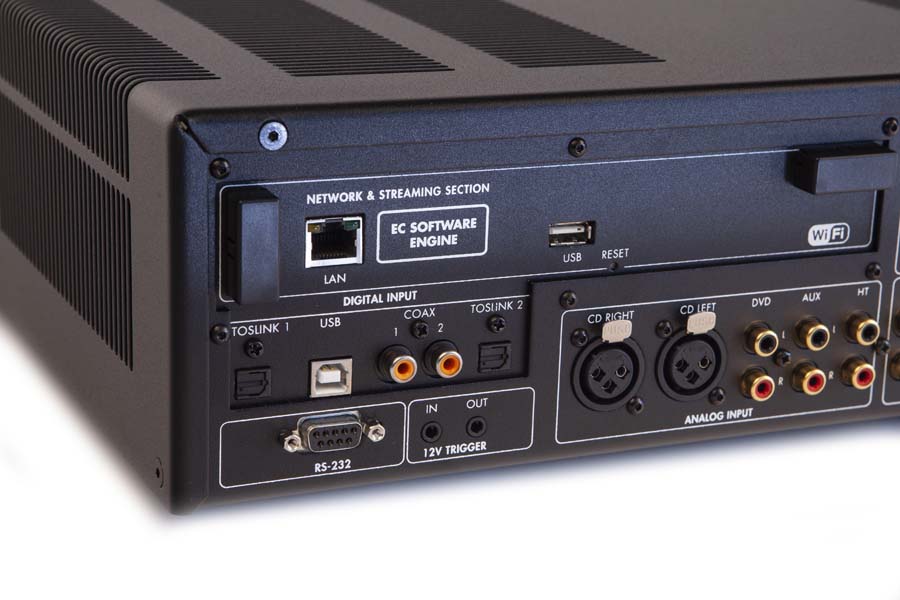
SOUND QUALITY
After having the 6DX in the rack for a couple of weeks, listening every day either as background while working or with more focus when time allowed, and moving between it and another review amp I have as well as my own reference amp (the Hegel H190) it was time to get down to proper critical listening. As usual, I have some go-to pieces that know really well and some others that just are so well recorded that they really help the listener hear what’s going on under the hood and how it may compare to other offerings.
First up is a collection of master quality recordings by the Dutch reel-to-reel music company STS played back on my recently refurbed Tascam 32. A broad collection of ballads, jazz, and classical, recorded at such high quality that nothing is left behind. When coming to classical pieces such as Gabi Rynvelds wonderful take on Ravel, Debussy, and Handel I was actually so distracted by how wonderful the music was and how “there” everything was that I forgot to really assess what was going on but of course – that was the assessment. Large and rich, well-timed with a smooth but not too glassy, natural reproduction and great imaging, the merest hint of warmth and veneer from bottom to mid, but wonderfully engaging to listen to.
Moving to I, Robot from Alan Parsons (MoFi) on vinyl that same vibrancy and weight of sound paired with a light touch and nimble treble had me tapping fingers and feet and reveling in the music, that super funk bassline and handclap of The Voice almost had me on my feet (almost!). The imaging and full bass really shine through and with the right room you feel very involved in the sound.
Switching gears to stream Trentmøller’s Obverse album (Qobuz 24/44.1) via the EC play app, and we get that pace, rhythm, and solid bass again. No slouch but definably weighty in its playback you’re getting a thumping, powerful drive that Trentmøller deserves, his dark, edgy atmospheric soundscapes catching you off guard as well as making your heart beat a bit faster – all conducted with aplomb by the 6DX. Streaming Bladerunner 2049 OST (16/44.1) from Qobuz via my Aries G1 via coax demonstrates again that the DAC implementation here has been handled very well – that bass is gut hitting and visceral, while the synth stabs, sweeps and piano hits are clear and gripping, although to my ears streaming directly from the Aries G1 does perform a little better than streaming via the 6DX’s DNLA render from the EC Play app – if only marginally so – the G1 streamer is more than double the £1000 price upgrade for the streaming module of the Electrocompaniet.
As I close the session with John Coltrane’s Love Supreme on SACD and its aching, ethereal celebration of his faith that is both challenging at times, but beautiful to listen to – nothing is taken away here. That strong “fullness” that Electrompaniet achieve with that minimal by design feedback on Class A design only serves to provide the very deserving bed on which to serve up this Jazz masterpiece. Overall I am left with a very contended and wry grin, a great satisfaction at a day’s musical enjoyment and am forced to give a nod of “well played” to the Norwegians. Moreover, it feels like more time with this amp would only offer up more and more enjoyment of it.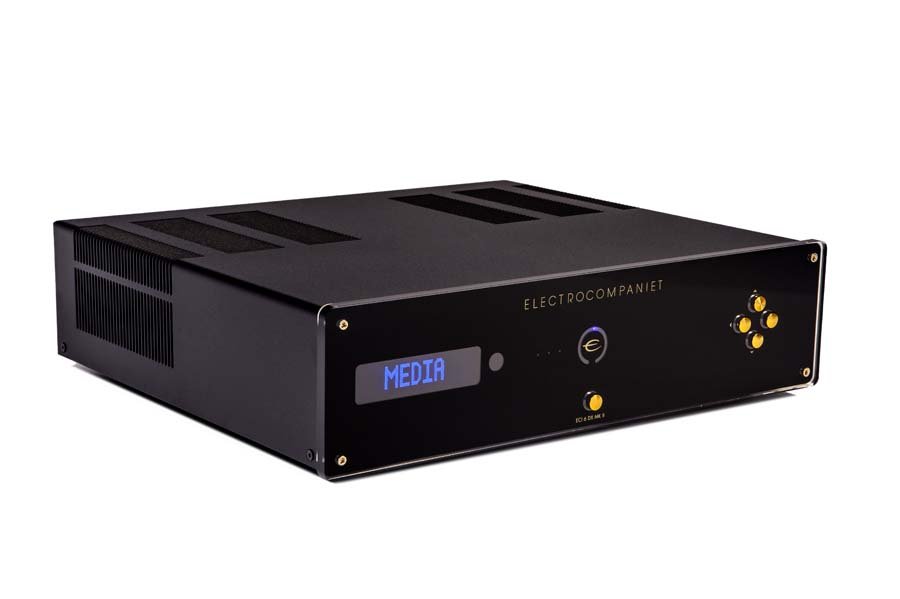
CONCLUSION
Across a broad spectrum of genres and formats the ECI 6DX MKII really serves up a very enjoyable listen. It drives hard and low when you need it too, with a strong warm and rich bass response but doesn’t sacrifice much at all further up the scale, with smooth, separated and open mid’s as well as good detail in the top sections, without being at all overly bright or jarring. Imaging is superb overall especially with recordings that offer it up well. At times the overall impression can be more fluid than clinical, a sheen more than a microscope on sound but that is no detractor as it’s very hard not to just sit back and get lost in music listening to the 6DX MKII. Speaker matching may well be warranted to ensure you really hit the mark for personal tastes, but that fullness in the bass, natural timbre and natural liveliness just pulls you in. Combining the construction, aesthetics, functionality and sheer sonic competency, Electrocompaniet have produced for me a very powerful package and a well-functioning amplifier/streamer that simply deserves to be listened to at a very reasonable price point. Their aim for a rewarding listening experience has been achieved, and then some.
AT A GLANCE
Build Quality: Solid, well thought, super range of inputs and pre-out including balanced, with stand-out aesthetics, a 22KG box of refined capability.
Sound Quality: Wonderful, rich and warm where you need it, strong across the board, detailed yet silky, seekers of clinical reproduction may want to consider careful speaker matching to cool the sound and open the mid’s and highs further but superbly enjoyable for hours on end.
Value For Money: Certainly this isn’t a budget offering for many, but Electrocompaniet have the pedigree to justify this price point and the wealth of inputs, high quality DAC/ streaming integration, build quality, power and of course sound quality for me do justify the investment. This is not a “buy now, upgrade later” solution, this is a long term keeper for me and many I would bet.
Pros:
Integration of DAC/Digital streaming and amplifier, plethora of inputs (inc Pre and HT), build quality, rich enjoyable sound, the application offered for both iOS and Android.
Cons:
Overly busy remote.
Blue LED readout possibly not for everyone.
Price: €5999 RRP, €4999 without the Streaming capabilities
Description
| All measurements are made at 120V / 240V //50Hz / 60Hz | |
| Digital section: | |
| D/A converter | 24 bit/192 kHz |
| Sample rate converter | 24bit / 192kHz |
| Inputs | SPDIF, 2x Toslink, 1x USB |
| USB: | asynchronous up to 24bit/ 192kHz supported |
| SPDIF: | 24bit/ 192kHz |
| Toslink: | 24bit/ 96kHz |
|
Streamer section |
|
| Streaming services • AirPlay ® • AirPlay 2 ® * • Spotify ® Connect • Qobuz ® • TIDAL ® • TIDAL ® Connect * • Roon Ready • DLNA • Internet Radio • Bluetooth streaming from any Bluetooth enabled device* Future software update. |
|
| Supported formats: • All popular formats including: WAV/WAVE, MP3, AAC+, Vorbis, ALAC, FLAC, APE, WMA, up to 192kHZ/24bit, DSD, up to DSD 128 (5.6 MHz) |
|
| Preamplifier section | |
| Input impedance
( Balanced input ) |
47Kohm |
| Maximum input level | 10 Volt RMS |
| Noise floor
( 1Vrms, 20 – 20 kHz, balanced) |
-135 dB |
| THD + N
(1Vrms, 20 – 20 kHz, balanced) |
<0.004% |
| Gain (Balanced) | 0 dB |
| Amplifier section | |
| Output Impedance | < 0,02 Ohm |
| Frequency response | 1 – 150 kHz |
| Channel separation | > 120 dB |
| THD ( 20 – 20 kHz) | < 0.004% |
| Maximum peak current | >100A |
| Damping factor 8 ohm load | >350 |
| I Input sensitivity 120W output | 1.3Vrms |
| Input sensitivity HT 120W output | 1Vrms |
| Gain HT Input | x36 (31 dB) |
| Rated output power | |
| 8 ohms | 2 x 125 W |
| 4 ohms | 2 x 200 W |
| 2 ohms | 2 x 370 W |
| Power consumption | 110 W |
| Standby | 1W |
| (no load or signal) | |
| Dimensions | |
| Width | 470 mm / 18.3 inches |
| Depth ( with a speaker terminals) | 430 mm / 16.9 inches |
| Height | 128 mm / 5 inches |
| Weight | 20,5 Kg / 45 lbs. |

